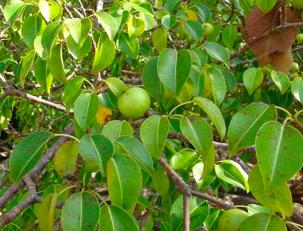The Everglades National Park in southern Florida is a place of beauty and also danger. It takes an airboat ride into the "swamp" (1) to fully appreciate the extent of both.Some dangers are worse than others. For example, There is a fish called a Jumping Oscar. Attractive, no?
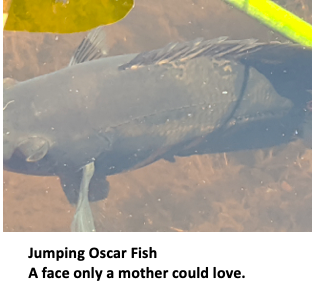
These bad boys didn't get their name by accident. The captain warned us that they can jump pretty high to snatch bugs out of the air. But two idiots on the boat refused to believe that the damn thing could jump more than a foot out of the water. Naturally, the requisite experiment was to wiggle our fingers about 13" above the surface of the water.
Bad move.

If you ask the average tourist to name the most dangerous living entity in the Everglades most will say crocodiles. Not even close. It's this...
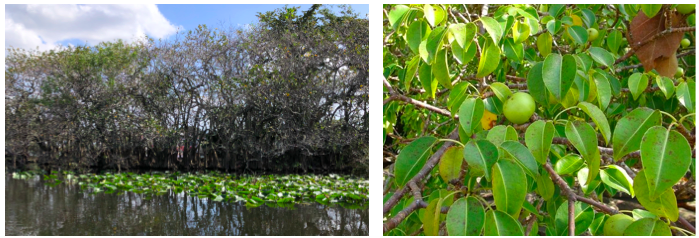
The Manchineel Tree. Stay the #### away. The fruit is called "beach apples." Photos: (Left) Yours truly. (Right) Owlication
The Manchineel tree, which grows between southern Florida and northern South America is considered to be the most dangerous tree in the world. Even touching any part of the tree can be fatal, although ghastly dermatological and eye symptoms are more likely. (You might want to skip the following photo.)
.
.
.
.
.
(Last chance...)
.
.
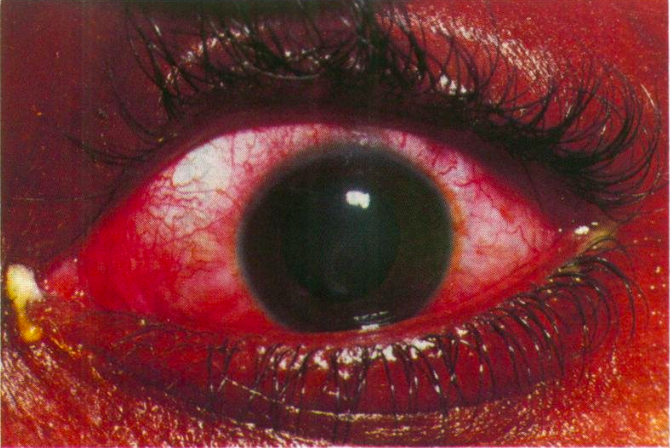
Machineel conjunctivitis - Nasty! Photo: British Journal of Ophthalmology
In fact, a short review article having the not-so-subtle name "Manchineel Apple of Death" was published in 2019. Some of the highlights:
- It is considered the most toxic tree on earth (in the 2011 Guinness book of records).
- Christopher Columbus referred to it as ‘manzanilla de la muerte’ or the little apple of death.
- It is unsafe to even stand under the tree in the rain. A group of four students in the Caribbean made this mistake and suffered Manchineel dermatitis and ophthalmitis. Exposure to tree sap can cause severe eye damage.
- Burning the wood releases toxic smoke (2)
- And finally... "Eating that manchineel ‘beach apple’ can turn out to be quite a toxic unpleasant experience."
Now, there's an understatement. This resulted in yet another Manchineel-related publication, this time in BMJ.
The title is sort of hilarious:
'Eating a manchineel “beach apple” '
'My most unfortunate experience'
Radiologist Nicola Strickland and a friend were enjoying a vacation in Tobago when they stumbled across some coconuts and mangoes on a beach. There was also a green fruit that looked like an apple so they tried it – a most unfortunate decision. It was a manchineel “beach apple.”
Things did not go well after that:
I rashly took a bite from this fruit and found it pleasantly sweet. My friend also partook (at my suggestion). Moments later we noticed a strange peppery feeling in our mouths, which gradually progressed to a burning, tearing sensation and tightness of the throat. The symptoms worsened over a couple of hours until we could barely swallow solid food because of the excruciating pain and the feeling of a huge obstructing pharyngeal lump. Sadly, the pain was exacerbated by most alcoholic beverages, although mildly appeased by pina coladas, but more so by milk alone.
And in case that's not bad enough...
Over the next eight hours our oral symptoms slowly began to subside, but our cervical lymph nodes became very tender and easily palpable. Recounting our experience to the locals elicited frank horror and incredulity, such was the fruit's poisonous reputation.
N. Strickland, BMJ. 2000 Aug 12; 321(7258): 428.
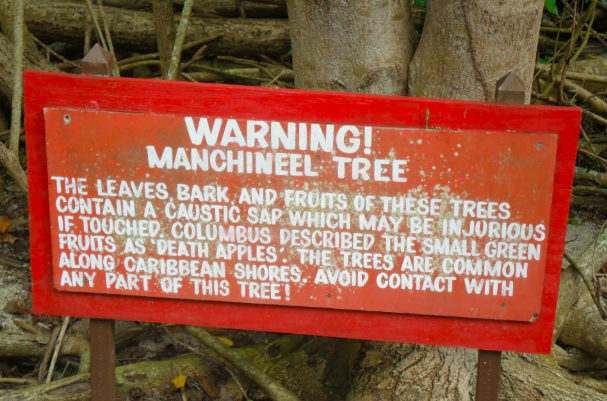
You probably ought to pay attention to this sign. Photo: Science Alert
What the hell is in this tree?
Chemicals. Natural chemicals. "Plant-based" (3) chemicals.
A number of toxic and carcinogenic chemicals have been identified from the tree, but the MVP is a natural product called phorbol.

Phorbol (left) is bad enough, but its esters (one example on the right) are far worse. The biological properties and mechanism of inflammation and tumor promotion have been discussed in detail.
I'm going to stop here because if I try to go into the details of how these compounds work one of three things will happen, all bad:
- I will scarf down a whopping slice of beach apple pie and die painfully before I write more.
- I will write more and then have the pie and die painfully.
- You will read it and then look for any pie I may not have finished. Then you will die painfully.
(But it will still not as painful as reading it)
One final note. Extracts of Manchineel trees from been used in folk herbal remedies in attempts to treat a number of maladies. elephantiasis. Look it up if need be, but you better not be squeamish.
Manchineel or elephantiasis. That's one damn fine choice.
NOTES:
(1) The Everglades is not really a swamp. It is a slow-moving river of fresh water originating in Lake Okeechobee, about 100 miles to the north.
(2) Interestingly, the lumber from these trees can be used for building, but not until it is allowed to sit out in the sun to decompose the toxins. I think I'll stick with Ikea.
(3) "Plant-based" is the latest stupid fad and marketing concept. If only we would stick to plant-based foods and other products then the earth will be safe forever because animals fart methane, which is a far worse greenhouse gas than CO2. In a 2019 New York Times article a group of climate scientists suggested that a "healthy low-carbon diet" could be based on plant-based meals. Bon appétit folks!
